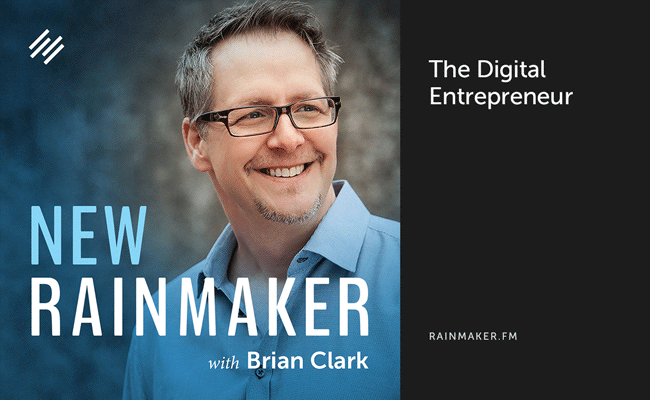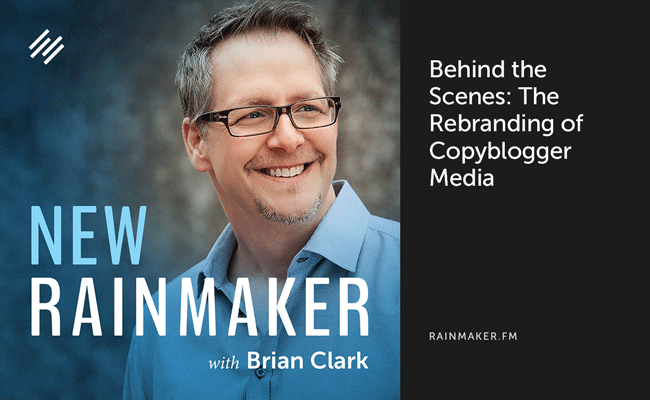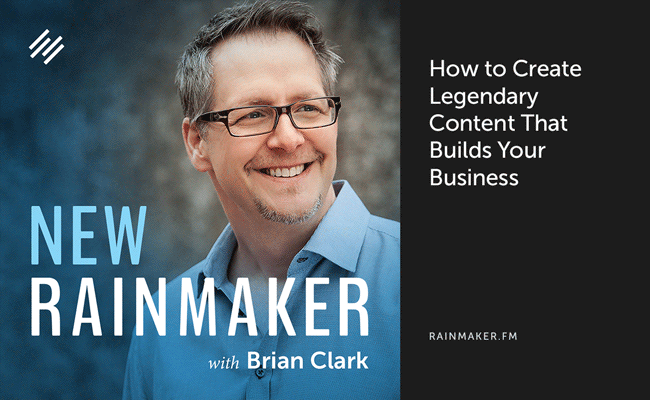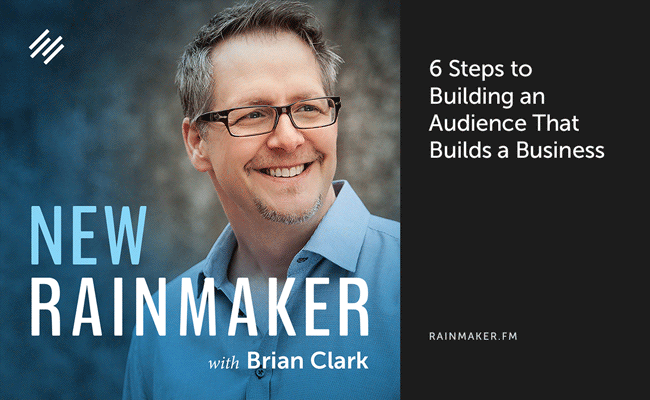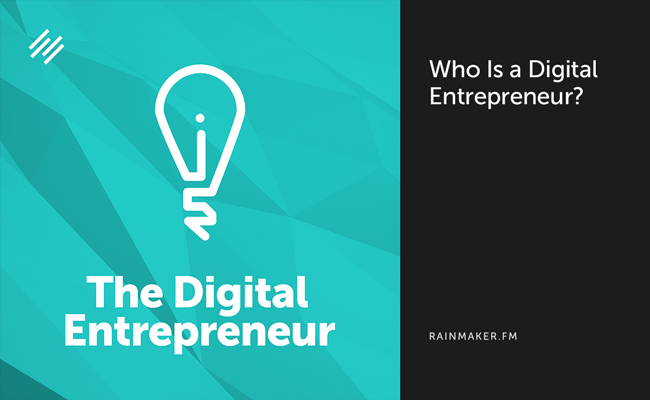
Are all entrepreneurs really digital entrepreneurs? A recent research paper posted this idea. We decided it would be the perfect jumping off point for the newest show on Rainmaker.FM: The Digital Entrepreneur.
In this 20-minute episode, Brian Clark and Jerod Morris discuss:
- The big idea for this new show
- How we define the term “digital entrepreneur”
- Whether AirBNB and Uber fit within our definition of digital commerce
- How emerging technologies like virtual reality might change everything
- What digital entrepreneurs need to succeed in digital commerce
Plus, we tease the upcoming series that will kick off The Digital Entrepreneur, which you won’t want to miss.
Listen to The Digital Entrepreneur below …
The Show Notes
- ZDNet Article: Every entrepreneur is a digital entrepreneur
- Digital Commerce Institute
- Brian Clark
- Jerod Morris
The Transcript
Who Is a Digital Entrepreneur?
Voiceover: You are listening to The Digital Entrepreneur, the show for folks who want to discover smarter ways to create and sell profitable digital goods and services. This podcast is a production of Digital Commerce Institute, the place to be for digital entrepreneurs.
DCI features an in-depth, ongoing instructional academy, plus a live education and networking summit where entrepreneurs from across the globe meet in person. For more information, go to DigitalCommerce.com.
Jerod Morris: Welcome, everybody, to the first episode of The Digital Entrepreneur. I am Jerod Morris, the VP of marketing for Rainmaker Digital and a digital entrepreneur myself, and I’m excited to be joined today by a name and a voice that you know well, serial digital entrepreneur Brian Clark, the founder and CEO of Rainmaker Digital. Brian, how do you like the new digs here at The Digital Entrepreneur?
Brian Clark: Oh yeah, I’m loving it. What we need now is another podcast for sure.
Jerod Morris: Yeah, it’s new show art, new music. You even got a new co-host here.
Brian Clark: New year, although it’s already February. How did that happen?
Jerod Morris: I don’t know. I really don’t. I looked up, and all of a sudden a month was gone. By the way, we have new intro music for the show. I don’t know if you know the title of the intro song, but its called ‘Men on a Mission,’ which I thought was appropriate since we are, in a sense, men on a mission here to teach people how to more effectively do digital commerce. So I thought that was a good name for …
Brian Clark: Yeah, I did notice that. Now, did Mr. Bruce pick out this music like he usually does?
Jerod Morris: He didn’t, actually. Jessica was the one who came with the ideas. She had a whole list. I made the final choice, and I think she did a good job.
Brian Clark: Cool.
Jerod Morris: Yes, yes. Let’s transition into our topic today. This is the first episode of The Digital Entrepreneur. In our last episode of New Rainmaker, we talked about what digital commerce is. I thought it would be appropriate to begin this episode by basically just talking about who is a digital entrepreneur.
Why Every Entrepreneur Is Now a Digital Entrepreneur
Jerod Morris: To kick the discussion off, you and I exchanged a few thoughts on an article that we read. It’s a ZDNet article that was talking about some research that Accenture did that basically found that new and emerging technology has the potential to help create up to 10 million new jobs for young people as entrepreneurs around the world step into the role of ‘digital entrepreneur.’
One of the statements in this article was, “Every entrepreneur is now a digital entrepreneur”–which I found interesting and I wanted to get your thoughts on to see if you agree with that or if you think that’s too broad of a statement.
Brian Clark: Both. I think there’s a lot of truth to that. As we move forward, that statement will become more and more literally true. Now, I don’t know any entrepreneur these days who isn’t using digital technology in some form–so in that sense, sure.
The flip side of that being too broad is the way we talk about digital commerce, we really are trying to limit it and delineate away from e-commerce or physical products by talking about products and services that literally exist online. They’re marketed, sold, delivered, supported–everything is basically a digital-environment transaction. There’s a range here of stuff that qualifies as that.
Obviously, one of the easiest or, I should say, lower-barrier-to-entry products is the self-published ebook business where entrepreneurs are sidestepping traditional publications, or publishers I should say, because it is a product that you can completely fulfill, market, and sell online and also create and put into digital format with minimal trouble, hassle, technical expertise.
Whether Airbnb and Uber Fit within Our Definition of Digital Commerce
Brian Clark: Then, if you really think about the outer reaches in the other direction, we like to talk about online courses, plug-ins, themes, software as a service, but if you look at Airbnb and Uber, these are not software as a service. They are software that facilitate services in the real world, but that is digital commerce.
For example, Uber made this point before. If you extrapolated Uber and replaced the entire taxi industry, that software app kills about 300,000 jobs. So it’s basically software platforms that are doing things in very disruptive ways through the ability to connect people. That is an outlier type of situation.
I don’t think I would ever represent to someone that I could teach them how to start the next Uber, but we can talk about software as a service. We can certainly talk about online courses, themes, plug-ins, downloadable software, all of this kind of stuff. I’d say, today, the truth of the matter is, digital technology is a huge part of any entrepreneurial effort whatsoever, whether it just be marketing, but its rarely ever just marketing anymore
I can think back to my real estate brokerage businesses. I never thought about it in this context, but it was all digital, even infrastructure. I never thought of it as a digital commerce company, but it set the stage for me to move into that, which, of course, I did in 2006. When you think about what I was doing at that time and then you look at what came after, like Zillow, that is a digital commerce platform.
I think we all get our feet wet, but the platforms and the technology that’s available to any entrepreneur, you’d have to be crazy not to take advantage of every digital technology that you can in order to be more efficient, to lower costs, to reach a larger market share, reach the right market share– whatever the case might be.
The Big Idea for This New Show
Jerod Morris: But our goal on The Digital Entrepreneur and, for example, our goal inside of Digital Commerce Academy isn’t necessarily to teach someone how to launch the next Airbnb or how to launch the next Uber, right?
Brian Clark: No. And honestly, quite a few of the people that are onboard with this have a digital business, and they’re really looking to find out more about how to grow. Then there is another subset of students who are getting their feet wet, so they are the ones thinking about leading with a gateway product, such as an ebook or developing their first course.
The bulk, if you look at the dollars spent on ebooks, the billions of dollars on online education, and billions of dollars on downloadable software and software as a service, it’s so much opportunity right there where you don’t have to be this person who’s trying to disrupt the whole world with this amazing platform. Interesting thing to me is, Airbnb didn’t start that way, either. They didn’t get really ambitious with their plans until they saw how they had developed something that could scale.
Jerod Morris: Okay. We’re going to spend some time on this show, obviously, diving in to the details and really giving people some tips that they can use to go out and execute effective digital commerce, but let’s think big here for a little bit. Where’s this going?
You and I talked the other day about virtual reality. We talked about how it’s the future of viewing sports, but you even mentioned something to me that that’s going to change how we interact online, different environments that are going to be created. Where is that going to potentially take us in the future?
How Emerging Technologies Like Virtual Reality Might Change Everything
Brian Clark: Yeah, it’s very interesting because you really can’t escape the buzz about virtual reality this year. 2016 will be the year that it kicks off. Now, what does that mean for how fast it matures, how fast it’s adopted, how well it takes over our lives?
As you and I discussed when we were riding to the airport the other day, you could imagine a scenario where people stay jacked in all day long and didn’t travel anymore because they could visit virtual destinations without expense or terrorism or whatever. It’s kind of mind boggling. It’s fascinating to me, but things aren’t going to move quite that fast.
But something that you can start thinking about is virtual environments where business is transacted in new and different ways that could possibly be done with the evolving and more powerful websites that we have these days. We’ll talk about that in just a minute, but I’m really interested in it. I’m not sure I have all the answers, but it is something that I’m intellectually attuned to and paying attention to.
I was just thinking about my audience over at Unemployable and was reading an article about digital contracts, effectively where you don’t have to trust the other person to do what’s on the paper. It’s almost like a digital escrow system where things happen, and if they happen, money is released. Could you imagine that when you’re a freelancer trying to get paid? There’s all sorts of business applications for adopting greater use of digital technology that are either just ideas at this point or they just don’t have the momentum yet.
Right now, this podcast is very nuts and bolts. If you haven’t created your first digital product yet, we want to get you there. If you’ve already got products but you’re just trying to grow and then maybe take it to the next level–product category, service category–we want to help you get there.
At the same time, we’re going to keep our eye on the cutting edge, and that’s why, of course, you’ve been putting on those Cutting Edge webinars inside Digital Commerce Academy. Those are going to be a lot of fun because that’s where we get to explore the edges.
Jerod Morris: So I can buy some virtual-reality goggles? That’s not even the right word. What would be the right term for virtual reality?
Brian Clark: It’s a headset.
Jerod Morris: A headset. Okay. So I can buy a virtual-reality headset and demo it?
Brian Clark: Someday it will be goggles, and hopefully it’ll be like contact lenses. It’s going to be interesting to see how it evolves, but for right now, it’s a big, clunky helmet.
Jerod Morris: Yeah, so we will all look really cool while we do it.
Brian Clark: Yeah, you don’t want to have guests over when you are in the metaverse or whatever.
Jerod Morris: No–unless everybody’s in there.
Brian Clark: Right.
Defining the Term ‘Digital Entrepreneur’
Jerod Morris: Okay. Getting back to the initial question for this episode before we move forward, just so we’re clear on who is the digital entrepreneur, who’s the person that we’re talking to. Is it as simple as saying that the digital entrepreneur that we’re talking to is someone who has created or has the desire to create a digital product or service that is marketed, delivered, and supported completely online? That’s our definition of digital commerce. That’s the person that we are talking to here.
Brian Clark: Yeah, that’s the working definition. I think it’s pretty solid. That doesn’t stop us from exploring hybrid situations or maybe expanding the definition as things change, but it actually is fundamentally sound. Any definition broader than that is really just stepping over into other terminology that we have had for decades, like e-commerce.
Jerod Morris: Yeah. So that’s who a digital entrepreneur is.
What Digital Entrepreneurs Need to Succeed in Digital Commerce
Jerod Morris: We’re going to move forward now in future episodes talking about what you need to succeed in digital commerce. Obviously, it’s going to start with creating a great product–whether that be a course, a SaaS product, an ebook, a theme, anything like that–which is what we’re working with folks inside of Digital Commerce Academy to do.
The next step once you then have that great product is understanding the fundamentals of marketing in the modern age. That great product that you have still is going to have to find a market, and that market is going to have to be compelled into taking action. That’s why we’re going to be talking about, in these future episodes, elements of the modern marketing website.
Do you want to tease that a little bit? This is an idea that you’ve been talking about that you and I worked on a little bit recently, and I’m excited to start exploring these ideas further.
Teaser: Upcoming Series to Kick Off The Digital Entrepreneur
Brian Clark: Yeah, I want to save the meat of this for upcoming episodes. In addition to creating the digital website experience, we’re obviously going to have people on–real-life practitioners, case studies–giving you ideas about how they developed their first products. It really comes down to two things, Jerod. It’s create and sell.
If you haven’t created yet, that doesn’t mean you can’t start the process that’s going to lead to sales, which we call ‘audience building.’ This is a big overlap with what we talk about on Copyblogger and content marketing in general, but there is even a more specific argument to be made.
Now, going back to our geeky extrapolations about virtual reality, there is no doubt in your mind, right, Jerod, that if you put on that clunky helmet, that you are there having this virtual-reality experience. Weren’t you the one who told me that there are some simulations where they tried to get people to walk off a cliff, and they could not do it because their brain just said, “No, I can’t do that”?
Jerod Morris: Yeah. Someone was telling me that. At CES, I think, they were doing a demonstration, and people were wearing the headset. It was a big nature scene that they were in, and it was so real that, when they told them to jump–they had reached a cliff–they couldn’t do it. Something had just happened in their brain that made it feel so real.
Brian Clark: Yeah, so no one would argue that isn’t a viable experience. Yet we hear the buzz terminology applied that ‘your website has to be an experience.’ Of course, all websites are an experience, but are they one that’s transformative? Are they one that provides value in a unique and evocative way that’s also helping you meet your business objectives?
That’s the way I want to frame these upcoming episodes when we’re talking about the elements. I’ve said this a couple times now, but the switch going on now in what constitutes a minimum viable digital website is shifting–just like it did from brochure sites to content-rich sites.
We’re not in the post-content era–content is more important than ever. But the actual way the site is constructed has to be thought out in a way that provides an overarching experience, not just a blog or whatever the case may be.
Jerod Morris: Yeah. We’ll spend some time on future episodes talking about that–what that means, what the elements are.
Brian Clark: I think we could kick off the very next episode with that topic.
Jerod Morris: I think we could.
Brian Clark: Why don’t we plan on that?
Jerod Morris: Lets do it.
Brian Clark: Also, see what else we can get lined up for people to get going. That’s the key here–again, whether it’s creating your first thing or accelerating the thing you’ve got.
Jerod Morris: And like you mentioned earlier, that’s what we’re doing with folks in Digital Commerce Academy. Hey, I wanted to ask you a real quick question here in closing. Obviously, you developed one of the first courses in Digital Commerce Academy, your course on courses. It was the first time that you had dug into that material in a while and put it into a course. How’s that experience been for you putting that course together and working with that material again?
The True Value of the Digital Commerce Academy
Brian Clark: The interesting thing about it is that a lot of the fundamentals from Teaching Sells that was our first product back in the day when people didn’t believe that people would pay for online education. Now it’s what, 15 billion a year?
Jerod Morris: Yeah.
Brian Clark: But the interesting thing about that course is it’s not really about making courses. It’s not just an instructional design course. If you look at the title, it’s really about the business of online courses, and that’s where people get lost. That’s where they make mistakes because they’re not understanding the market research and what people are actually looking for when they create a course.
I’ll admit that I could send you to Amazon to read a book on instructional design if you just want to make a course. That doesn’t mean anyone’s going to buy it. That’s the fundamental difference of that course. It truly is a business education that involves online education as opposed to, “Here’s what you do first to make a course ,” that kind of thing.
That’s the important distinction. You’ll find, throughout all our instruction, all our Q&As, all our case studies, all the webinars in Digital Commerce Academy, that it is nuts and bolts business-focused. We are not here and you are not there to do things that are not pursuing your dreams, your business objectives. The goal of an entrepreneur is to bring a product to market successfully, and that’s our focus.
Jerod Morris: Yep. Absolutely. If you want more information on that to check out that course, you can go to DigitalCommerce.com. To learn more about everything else that we talked about in this episode, stick with us. We’re going to have some fun over these next few weeks and well beyond for The Digital Entrepreneur, very excited about it. And, Brian, jump off the cliff.
Brian Clark: I have no choice. It’s daily.
Jerod Morris: All right. We will talk to you next week, everybody.
